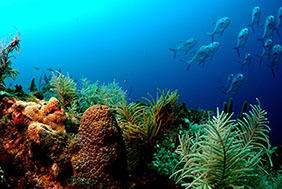-
Home
-
Data & Publications
-
Regional Portals
- About Regional Portals
- Florida
- Navassa Island
- Puerto Rico
- Flower Garden Banks
- U.S. Virgin Islands
- American Samoa
- Commonwealth of the Northern Mariana Islands
- Federated States of Micronesia
- Guam
- Main Hawaiian Islands
- Republic of the Marshall Islands
- Northwestern Hawaiian Islands
- Republic of Palau
- Pacific Remote Island Areas
-
CRCP Activities
- Glossary
Capacity Shortfalls Hinder the Performance of Marine Protected Areas Globally

A heightened awareness of human impacts on marine biodiversity has been the impetus for the largest expansion of marine protected areas (MPAs) ever. Possibly because of this recent, rapid expansion, however, it is still unknown whether many MPAs are being managed properly, and how the management of these MPAs is currently influencing their outcomes.
The authors of this article have developed a global database of management and fish population data in order to assess the effectiveness of MPA management and the effect that this management has on fish populations. In this article, the authors report that many MPAs did not meet thresholds for effective management, in large part due to lack of financial resources and an inadequate number of staff. Although the majority of MPAs positively influenced fish populations, the impacts were greatly varied. Among other variables, the staff and budget capacity of MPAs had the strongest correlation to the overall conservation impact. For example, MPAs with adequate staff capacity had positive ecological effects 2.9 times greater than MPAs with inadequate capacity.
In this paper the authors argue that continued global expansion of MPAs without investment in human and financial capacity is likely to lead to sub-optimal conservation outcomes.
Citation: Gill et al. 2017. Capacity shortfalls hinder the performance of marine protected areas globally. Nature; doi: 10.1038/nature21708.
Direct questions or comments to:


